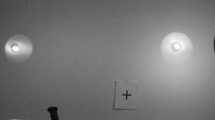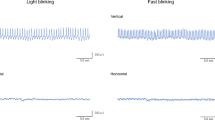Abstract
Background
A number of recent studies have reported high spontaneous eyeblink rate (SEBR) values in apparently normal subjects, but the reasons for this are unclear.
Methods
An assessment was made of SEBR, in 60 educated adult male subjects aged between 22 and 40 years, over a period of 5 min in silence. Half of the subjects were classified as having frequent eyeblink activity. All subjects also had their corneal and conjunctival touch (tactile) sensitivity assessed with a Cochet-Bonnet aesthesiometer immediately after the video recording of SEBR.
Results
SEBR ranged from 4.6 to 43.5 (mean 18.6) eyeblinks/min. The SEBR was 26.8 ± 6.0 eyeblinks/min for those with frequent eyeblink activity as compared to just 10.3 ± 3.5 eyeblinks/min for those with normal eyeblink activity (p < 0.001). There was no difference in palpebral aperture or exposed ocular surface area between the two groups. The average central corneal sensitivity was only marginally different between the two groups (56.8 ± 2.8 mm vs 58.5 ± 2.3 mm) but the conjunctival threshold sensitivity was substantially different (at 23.8 ± 4.3 mm vs 28.5 ± 3.5 mm; p < 0.001). SEBR was inversely correlated with the conjunctival sensitivity in those with frequent eyeblink activity (p < 0.001).
Conclusions
Our study provides a clue as to the mechanism of inhibition of spontaneous eyeblink activity, namely that a certain level of ocular surface (conjunctival) sensitivity is required to keep SEBR low.





Similar content being viewed by others
References
Ponder E, Kennedy WP (1927) On the act of blinking. Q J Exp Physiol 18:89–110
Stern JA, Walrath LC, Goldstein R (1984) The endogenous eyeblink. Psychobiol 21:22–33
Karson CN (1988) Physiology of normal and abnormal blinking. Adv Neurol 49:25–37
Vreugdenhil H, Brouwers P, Wolters P, Bakker D, Moss H (1997) Spontaneous eye blinking, a measure of dopaminergic function, in children with acquired immunodeficiency syndrome. Arch Pediatr Adolesc Med 151:1025–1032
Tsubota K, Kwong KK, Lee T-Y, Nakamura J, Cheng H-M (1999) Functional MRI of brain activation by eye blinking. Exp Eye Res 69:1–7. doi:10.1006/exer.1999.0660
Bour LJ, Aramideh M, Ongerboer de Visser BW (2000) Neurophysiological aspects of eye and eyelid movements during blinking in humans. J Neurophysiol 83:166–176
Doughty MJ (2001) Consideration of three types of spontaneous eyeblink activity in normal humans: during reading and video display terminal use, in primary gaze, and while in conversation. Optom Vis Sci 78:712–725. doi:10.1097/00006324-200110000-00011
Bentivoglio AR, Bressman SB, Cassetta E, Carretta D, Tonali P, Albanese A (1997) Analysis of blink rate patterns in normal subjects. Mov Disord 12:1028–1034. doi:10.1002/mds.870120629
Zaman ML, Doughty MJ, Button NF (1999) The exposed ocular surface and its relationship to spontaneous eyeblink rate in elderly Caucasians. Exp Eye Res 67:681–686. doi:10.1006/exer.1998.0571
Mori A, Egami F, Nakamori K, Ohtsuki T, Aikawa K, Shintani M, Matsumoto Y, Goto E, Tsubota K (2008) Quantitative videographic analysis of blink patterns of newscasters. Graefes Arch Clin Exp Ophthalmol 246:1449–1453. doi:10.1007/s00417-008-0887-3
Sforza C, Rango M, Galante D, Bresolin N, Ferrario VF (2008) Spontaneous blinking in healthy persons: an optokinetic study of eyelid motion. Ophthalmic Physiol Opt 28:345–353. doi:10.1111/j.1475-1313.2008.00577.x
Kleno J, Wolkoff P (2004) Changes in eye blink frequency as a measure of trigeminal stimulation by exposure to limonene oxidation products, isoprene oxidation products and nitrate radicals. Int Arch Occup Environ Health 77:235–243. doi:10.1007/s00420-003-0502-1
Tsubota K, Hara S, Okusawa Y, Egami F, Ohtsuki T, Nakamori K (1996) Quantitative videographic analysis of blinking in normal subjects and patients with dry eye. Arch Ophthalmol 114:715–720
Acosta MC, Gallar J, Belmonte C (1999) The influence of eye solutions on blinking and ocular comfort at rest and during work at a video display terminals. Exp Eye Res 68:663–669. doi:10.1006/exer.1998.0656
Walker JC, Kendal-Reed M, Utell MJ, Cain WS (2001) Human breathing and eye blink rate responses to airborne chemicals. Environ Health Perspect 109(suppl 4):507–512. doi:10.2307/3454661
Wolkoff P, Nojgaard JK, Toiano P, Picoli B (2005) Eye complaints in the office environment: precorneal tear film integrity influenced by eye blinking frequency. Occup Environ Med 62:4–12. doi:10.1136/oem.2004.016030
Kugelberg E (1952) Facial reflexes. Brain 75:385–396. doi:10.1093/brain/75.3.385
Millodot M (1973) Objective measurement of corneal sensitivity. Acta Ophthalmol (Copenh) 51:325–334
Gallar J, Acosta MC, Gutiérrez AR, Belmonte C (2007) Impulse activity in corneal sensory nerve fibers after photorefractive keratectomy. Invest Ophthalmol Vis Sci 48:4033–4037. doi:10.1167/iovs.07-0012
Huber P (1962) Untersuchungen über die Beeinflussung des spontanen Lidschlages durch Lokal-Anaesthetica. Graefes Arch Clin Exp Ophthalmol (forerunner) 164:594–611. doi:10.1007/BF00682809
Collins M, Seeto R, Campbell L, Ross M (1989) Blinking and corneal sensitivity. Acta Ophthalmol (Copenh) 67:525–531
Nakamori K, Odawara M, Nakajima T, Mizutani T, Tsubota K (1997) Blinking is controlled primarily by ocular surface conditions. Am J Ophthalmol 124:24–30
Fruedenthaler N, Neuf H, Kadner G, Schlote T (2003) Characteristics of spontaneous eyeblink activity during video display terminal use in healthy volunteers. Graefes Arch Clin Exp Ophthalmol 241:914–920. doi:10.1007/s00417-003-0786-6
Naase T, Doughty MJ, Button NF (2005) An assessment of the pattern of spontaneous eyeblink activity under the influence of topical ocular anaesthesia. Graefes Arch Clin Exp Ophthalmol 243:306–312. doi:10.1007/s00417-004-0990-z
Barbarato G, Ficca G, Muscettola G, Fichele M, Beatrice M, Rinaldi F (2000) Diurnal variation in spontaneous eye-blink rate. Psychiatry Res 93:145–151. doi:10.1016/S0165-1781(00)00108-6
Doughty MJ, Blades KA, Ibrahim N (2002) Assessment of the number of eye symptoms and the impact of some confounding variable for office staff in non-air-conditioned buildings. Ophthalmic Physiol Opt 22:143–155. doi:10.1046/j.1475-1313.2002.00013.x
Zaman ML, Doughty MJ (1997) Some methodological issues in the assessment of the spontaneous eyeblink in man. Ophthalmic Physiol Opt 17:421–432
Doughty MJ (2002) Further assessment of gender- and blink pattern-related differences in the spontaneous eyeblink activity in primary gaze in young adult humans. Optom Vis Sci 79:439–447. doi:10.1097/00006324-200207000-00013
Cochet P, Bonnet R (1960) L’esthésie cornéene. Sa mesure clinique. Clin Ophtalmol 4:3–27
Terry RL, Schnider CM, Holden BA, Cornish R, Grant T, Sweeney D, La Hood D, Back A (1993) CCLRU standards for success of daily and extended wear contact lenses. Optom Vis Sci 70:234–243. doi:10.1097/00006324-199303000-00011
Doughty MJ, Naase T (2006) Further analysis of the human spontaneous eyeblink rate by a cluster analysis-based approach to categorize individuals with ‘normal’ versus ‘frequent’ eye blink activity. Eye Contact Lens 32:294–299. doi:10.1097/01.icl.0000224359.32709.4d
Schellini A, Sampaio AA, Hoyama E, Cruz AAV, Padovani CR (2005) Spontaneous eye blink analysis in the normal individual. Orbit 24:239–242. doi:10.1080/01676830590922057
De Pavia CS, Pflugfelder SC (2004) Corneal epitheliopathy of dry eye induces hyperesthesia to mechanical air jet stimulation. Am J Ophthalmol 137:109–115. doi:10.1016/S0002-9394(03)00897-3
Jalavisto E, Orma E, Tawast M (1951) Ageing and relation between stimulus intensity and duration in corneal sensibility. Acta Physiol Scand 23:224–233. doi:10.1111/j.1748-1716.1951.tb00812.x
Manning KA, Evinger C (1986) Different forms of blinks and their two-stage control. Exp Brain Res 64:579–588. doi:10.1007/BF00340495
Helland M, Horgen G, Kvikstad TM, Garthus T, Bruenech JR, Aaras A (2008) Musculoskeletal, visual and psychsocial stress in VDU operators after moving to an ergonomically designed office landscape. Appl Ergon 39:284–295. doi:10.1016/j.apergo.2007.10.005
Aakre BM, Doughty MJ (2007) Are there differences between ‘visual symptoms’ and specific ocular symptoms associated with video display terminal (VDT) use? Cont Lens Anterior Eye 30:174–182. doi:10.1016/j.clae.2007.01.001
McMonies CW (2007) Incomplete blinking: Exposure keratopathy, lid wiper epitheliopathy, dry eye, refractive surgery, and dry contact lenses. Cont Lens Anterior Eye 30:37–51. doi:10.1016/j.clae.2006.12.002
Peshori KR, Schicatano EJ, Gopalaswamy R, Sahay E, Evinger C (2001) Aging of the trigmeninal blink system. Exp Brain Res 136:351–363. doi:10.1007/s002210000585
Dimitrova A, Weber J, Maschke M, Elles H-G, Kolb FP, Forsting M, Diener H-C, Timmann D (2002) Eyeblink-related areas in human cerebellum shown by fMRI. Hum Brain Mapp 17:100–115. doi:10.1002/hbm.10056
Powers AS, Schicatano EJ, Basso MA, Evinger C (1997) To blink or not to blink: inhibition and facilitation of reflex blinks. Exp Brain Res 113:283–290. doi:10.1007/BF02450326
Xu KP, Yagi Y, Tsubota K (1996) Decrease in corneal sensitivity and change in tear function in dry eye. Cornea 15:235–239. doi:10.1097/00003226-199605000-00002
Bourcier T, Acosta MC, Borderie V, Borras F, Gallar J, Bury T, Laroche L, Belmonte C (2005) Decreased corneal sensitivity in patients with dry eye. Invest Ophthalmol Vis Sci 46:2341–2345. doi:10.1167/iovs.04-1426
Ongerboer de Visser BW, Bour LJ (2006) Eye and eyelid movements during blinking: an eye blink centre? Clin Neurophysiol 58(suppl):16–25
Peterson J, Allison LW (1931) Controls of the eye-wink mechanism. J Exp Psychol 14:144–154. doi:10.1037/h0070197
Colzato LS, van Wouwe NC, Hommel B (2007) Spontaneous eyeblink rate predicts the strength of visuomotor binding. Neuropsychologia 45:2387–2392. doi:10.1016/j.neuropsychologia.2007.03.004
Acknowledgements
The authors would like to thank Dr. Emil Oblak, Joanna Ross, Julie McWhirter, Hashmi Gor and Elaine Milne for assistance in collection of some of the eyeblink and sensitivity data in pilot studies.
Author information
Authors and Affiliations
Corresponding author
Rights and permissions
About this article
Cite this article
Doughty, M.J., Naase, T. & Button, N.F. Frequent spontaneous eyeblink activity associated with reduced conjunctival surface (trigeminal nerve) tactile sensitivity. Graefes Arch Clin Exp Ophthalmol 247, 939–946 (2009). https://doi.org/10.1007/s00417-008-1028-8
Received:
Revised:
Accepted:
Published:
Issue Date:
DOI: https://doi.org/10.1007/s00417-008-1028-8




